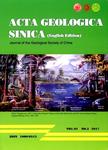Estimation of 2-D and 3-D Fracture Densities from 1-D Data-Experimental and Field Results
Estimation of 2-D and 3-D Fracture Densities from 1-D Data - Experimental and Field Results作者机构:InstituteofGeologyChinaSeismologicalBureauBeijing100029China DepartmentofGeologyStateUniversityofNewYorkatBuffaloNY14260USA
出 版 物:《Acta Geologica Sinica(English Edition)》 (地质学报(英文版))
年 卷 期:2003年第77卷第4期
页 面:491-503页
核心收录:
学科分类:081803[工学-地质工程] 08[工学] 0818[工学-地质资源与地质工程]
基 金:supported by the National Natural Science Foundation of China grant No.40272111 the Rock Fracture Project at the State University of New York at Bufalo
主 题:fracture frequency fracture density fracture network
摘 要:2-D and 3-D densities of fractures are commonly used in mining safety design, natural gas and oil production in fractured reservoirs, and the characterization of subsurface flow and transportation systems in fractured rocks. However, many field data sets are collected in 1-D frequency (f) (e.g., scanlines and borehole data). We have developed an ARC/ INFO-based technology to calculate fracture frequency and densities for a given fracture network. A series of numerical simulations are performed in order to determine the optimal orientation of a scanline, along which the maximum fracture frequency of a fracture network can be obtained. We calculated the frequency (f) and densities (both D1 and D2) of 36 natural fracture trace maps, and investigated the statistical relationship between fracture frequency and fracture density D1, i.e. D1=1.340f+ 0.034. We derived analytical solutions for converting dimensional density (D1) to non-dimensional densities (D2 and D3) assuming that fracture length distribution follows an exponential or power law. A comparison between observed and calculated results based on the equations we developed shows that (1) there exists a linear relationship between fracture frequency and fracture density (D1), and this relationship can be used to estimate fracture density (D1) if the fracture frequency is determined from a scanline survey or from borehole data; (2) the analytical solutions we derived can accurately determine the non-dimensional 2-D fracture density (D2) in practice and 3-D fracture density (D3) in theory if the fracture length distribution function is assumed.



